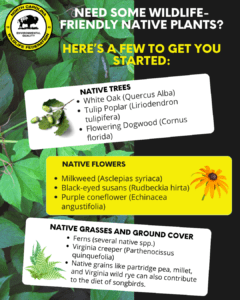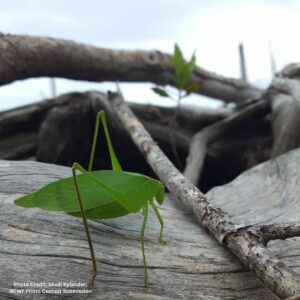Cultivating Habitat: 10+ Ways to Enhance Your Property for Pollinators

What are some practical ways you can enhance your property for pollinators? We’ve got you covered.
“A thing is right when it tends to preserve the integrity, stability and beauty of the biotic community. It is wrong when it tends otherwise.” – Aldo Leopold, A Sand County Almanac
Our state features three distinct biomes – the Mountains, the Piedmont and the Coastal Plain. Biodiversity abounds as species vary from

place to place in North Carolina.
While your neighborhood in the Piedmont might boast a flourishing community of white-tailed deer, you may never catch sight of a black-capped chickadee, exclusive to the state’s mountain region.
Whether you live at sea level along the coast or high up in the mountains of North Carolina, encountering a black bear wandering through your property is a possibility, yet catching a glimpse of the elusive American woodcock remains a statewide rarity.
Regardless of your location, one thing remains constant: the presence of one of the most significant subsets of wildlife in the state—pollinators.
Help Our Pollinators
 While the monarch butterfly has garnered the spotlight over the years for its vital pollinating role, stunning beauty, and precarious plight, it does not work alone in its pollinating prowess. A diverse array of pollinators are absolutely essential to the prosperity of plant life across our state.
While the monarch butterfly has garnered the spotlight over the years for its vital pollinating role, stunning beauty, and precarious plight, it does not work alone in its pollinating prowess. A diverse array of pollinators are absolutely essential to the prosperity of plant life across our state.
Unfortunately, many of these pollinators face mounting pressures and declining populations due to habitat loss, urbanization, pollution, invasive plants, disease and detrimental agricultural and landscaping practices.
The state’s Wildlife Action Plan, crafted by the North Carolina Wildlife Resources Commission (NCWRC) and partners, identifies numerous pollinator species in need of conservation efforts. These species offer an invaluable pollinating service to a wide range of native plant species throughout the state, including those that mitigate erosion, provide shelter for wildlife, secure our food supply, moderate climate, and more.
In this blog, we are going to share a few practical applications that you can easily incorporate into your property to support pollinators.
Pollinators – and wildlife, in general – require four essentials for survival: food, water, shelter, and places to raise young. Each category listed below provides a few projects that meet each one of these essentials. As an added bonus, we included a section on sustainable practices that will benefit pollinators and contribute to the general sustainability of your property. By making these practical enhancements to your land, you can make it a true property for pollinators.
Enhancing Your Property for Pollinators – Food
 Native plants provide food and habitat to native wildlife that have learned to coexist with them over millions of years. This symbiotic relationship has formed between North Carolina’s flora and fauna, producing a vibrant ecological community that functions like a well-oiled machine with many intricate and overlapping parts.
Native plants provide food and habitat to native wildlife that have learned to coexist with them over millions of years. This symbiotic relationship has formed between North Carolina’s flora and fauna, producing a vibrant ecological community that functions like a well-oiled machine with many intricate and overlapping parts.
But the introduction of invasive, nonnative plant species has thrown a wrench into the machine, causing harm to natural landscapes across the state, making it difficult for native plants and wildlife to adapt and access competitive resources.
Planting native plants benefits wildlife, and is a great step towards making your yard a property for pollinators. Native plants attract and support insects, including pollinators vital to environmental health. When these plants go to seed, they provide a valuable food source for seed-eating birds and small mammals.
Here are some things to consider when removing invasive species and planting natives in their stead:
- Plant Selection: Choose a variety of native flowering plants that are adapted to your region’s soil and climate conditions. Research native species of wildflowers, shrubs, grasses and trees that bloom at different times throughout the year to provide a continuous source of nectar and pollen.
- Habitat Restoration: Incorporate native plants into your landscape design to restore natural habitats for pollinators. Create meadows, prairies, or wildflower gardens that mimic native ecosystems and support a wide range of pollinator species.
- Pollinator Preferences: Select plants that are specifically attractive to pollinators, such as milkweed for monarch butterflies, or native species of aster and goldenrod for bees and butterflies.
Enhancing Your Property for Pollinators – Water
Offering a bird bath or a small fountain with chemical-free flowing water provides wildlife with a spot to hydrate and engage in bathing activities. This could manifest as a compact backyard bubbler, a meandering stream feature, or another variant of a water feature. Either way, this is a crucial element in creating property for pollinators.
Ensure that the water source is free from chemicals and dyes, and that there is ample cover along its edges.
Here are some other things to consider when providing water to pollinators:
Pond:
- Design Considerations: When planning a pond, consider factors such as size, depth, and location to create a suitable habitat for aquatic and semi-aquatic species. Incorporate shallow areas with gradual slopes to facilitate access for drinking and bathing by pollinators and other wildlife.
- Native Plantings: Surround the pond with native aquatic plants like water lilies, rushes, and cattails to provide additional habitat and food sources for pollinators. These plants also help maintain water quality by filtering pollutants and reducing erosion.
- Safety Measures: Install features like rocks, logs, and floating platforms to provide escape routes for wildlife and prevent accidental drownings. Avoid the use of chemical treatments or algaecides that can harm aquatic insects and amphibians.
Bird Bath: - Design Variety: Offer a range of bird baths in different sizes, shapes, and depths to accommodate various bird and pollinator species. Choose materials like ceramic, concrete, or plastic that are easy to clean and maintain.
- Placement Tips: Position bird baths in shaded areas to prevent water from overheating and becoming stagnant. Place them near vegetation or perches to provide cover and safety for wildlife while they drink and bathe.
- Hygiene Practices: Clean bird baths regularly with a mild bleach solution to remove algae, bacteria, and debris. Replace water every few days to prevent mosquito breeding and ensure a fresh water supply for birds and pollinators.
Enhancing Your Property for Pollinators – Cover
There are many ways to provide cover for pollinators, as it is a necessity that they require throughout all of their life phases – from larval to adult and from hibernation season to pollination season.

Brush piles and deadfall benefit a variety of wildlife species.
Here are some ideas to provide cover on your property for pollinators:
Brush Piles and “Leaving the Leaves”:
- Construction Methods: Stack branches, logs, and other organic debris in loose piles to create sheltered spaces for wildlife. Leave gaps and openings in the pile to allow access for small mammals, reptiles, and insects.
- Natural Decomposition: Allow brush piles to decompose naturally over time, providing food and habitat for decomposers like fungi and insects. Periodically replenish the pile with fresh materials to maintain its structural integrity and attractiveness to wildlife.
- Wildlife Benefits: Brush piles provide essential cover for pollinators during extreme weather events and serve as nesting sites for birds and small mammals. They also attract insectivorous birds and predators that help control pest populations in your garden.
Evergreen Shrubs: - Year-Round Appeal: Select evergreen shrubs that retain their foliage throughout the year, providing continuous cover and shelter for pollinators. Choose species with dense branching habits and foliage that offer protection from harsh weather and predators.
- Native Options: Research native evergreen shrubs that are well-suited to your region’s soil and climate conditions. Consider factors like mature size, growth rate, and wildlife value when selecting species for your landscape.
- Habitat Enhancement: Plant evergreen shrubs along property boundaries, near feeding and nesting areas, or as understory plantings beneath larger trees. Create clusters or drifts of shrubs to mimic natural habitats and provide a diverse range of microclimates for pollinators.
Enhancing Your Property for Pollinators – Places to Raise Young
Its important to provide safe places for pollinators to nest and raise young throughout all life stages. When designing these areas, think about
 every facet of nesting location, to ensure that you are not exposing pollinators to harsh elements, high-traffic areas, predator danger, or chemical exposure.
every facet of nesting location, to ensure that you are not exposing pollinators to harsh elements, high-traffic areas, predator danger, or chemical exposure.
Mature Trees:
- Preservation Efforts: Preserve healthy trees on your property to provide essential habitat for nesting pollinators and other wildlife species. Protect trees from damage during construction projects and avoid unnecessary pruning or removal.
- Species Diversity: Maintain a diverse mix of tree species to support a wide range of wildlife populations. Include native trees that produce flowers, fruits, nuts, and seeds favored by birds and mammals.
Nesting Boxes:
- Pollinator Hotels: Install bee hotels crafted to mimic natural nesting sites for solitary bees and other pollinators. Opt for sturdy materials such as untreated wood or recycled plastic, ensuring weather-resistance and insulation to protect developing eggs and larvae.
- Placement Guidelines: Hang nesting boxes at appropriate heights and orientations to minimize disturbance and maximize occupancy by target species.
Enhancing Your Property for Pollinators – Sustainable Practices
Many sustainable practices prioritize whole ecosystem function. Whereas composting or recycling may not seem like a practice that would directly benefit pollinators, these activities positively impact pollinators and other wildlife species.
Less Pesticides:
- Integrated Pest Management: Implement an integrated pest management (IPM) approach to minimize reliance on chemical pesticides. Monitor pest populations regularly and use cultural, mechanical, and biological control methods to manage infestations.
- Natural Predators: Encourage natural predators like ladybugs, lacewings, and predatory wasps by providing habitat and food sources such as nectar-rich flowers and insect shelters. These beneficial insects help control pest populations without the need for chemical interventions.
- Organic Alternatives: Use organic pest control products and methods whenever possible, including insecticidal soaps, neem oil, and diatomaceous earth. These natural remedies are less harmful to pollinators and other beneficial insects while still effectively managing garden pests.
Composting:
- Material Selection: Compost a mix of organic materials including kitchen scraps, yard waste, and garden trimmings to create nutrient-rich soil amendments. Balance green (nitrogen-rich) and brown (carbon-rich) materials to maintain proper decomposition and microbial activity.
- Composting Techniques: Choose a composting method that suits your space, time, and resources, such as traditional compost bins, tumblers, or vermicomposting with worms. Turn and aerate the compost regularly to speed up decomposition and prevent odors.
- Soil Health Benefits: Amend garden soil with compost to improve its structure, fertility, and water retention capacity. Healthy soil supports robust plant growth and enhances the availability of nutrients for pollinators and other beneficial organisms.
Are you passionate about pollinators and concerned about their future here with us? Consider registering your yard as a Pollinator Pitstop on NCWF’s Butterfly Highway.
Want more content like this? We’ve got you covered…
Written by:

– Bates Whitaker, NCWF Communications & Marketing Manager

– Luke Bennett, NCWF Conservation Coordinator


